- Joined
- Feb 2, 2011
- Messages
- 2,093
NEW RELEASES FOR DECEMBER 2024
THE SECOND WORLD WAR
GERMAN ARMOUR
German Sturmgeschütz III Ausf. G (Sd.Kfz. 142/1)
Initial Production
Sturmgeschütze Abteilung Grossdeutschland
Third Battle of Kharkov, February-March 1943
The final model of the iconic Sturmgeschütz III was the Ausfürung G, which began production in December 1942. The most noticeable upgrades to the StuG III Ausf. G was a newly designed commander's cupola that provided all-around viewports and an enlarged armored casemate that extended over the pannier sides of the hull, providing the StuG crew with a more spacious fighting compartment. Early StuG III Ausf. Gs were armed with the powerful long barrelled 7.5cm StuK 40/L48 cannon, capable of knocking out Russian T-34s and KV-1s at long range, and protected by 50mm of armor reinforced with additional 30mm armor plates bolted on top, for a total armor thickness of 80mm that provided excellent protection from the 76.2mm cannon of Russian tanks. Lastly, while in late 1942 Stug IIIs were leaving the assembly firms painted in the second Tropical camouflage scheme, photographic evidence confirms that some of the initial production StuG III Gs left the assembly firms painted in RAL 7021 Dunkelgrau...the iconic dark grey of early war German armor! Some of these grey Stug III Ausf. Gs were issued to none other than the Heer's elite unit, Infanterie-Division (Motorized) Grossdeutschland, when it participated in Generalfeldmarschall Erich von Manstein's brilliant counteroffensive during the Third Battle of Kharkov from February - March 1943.
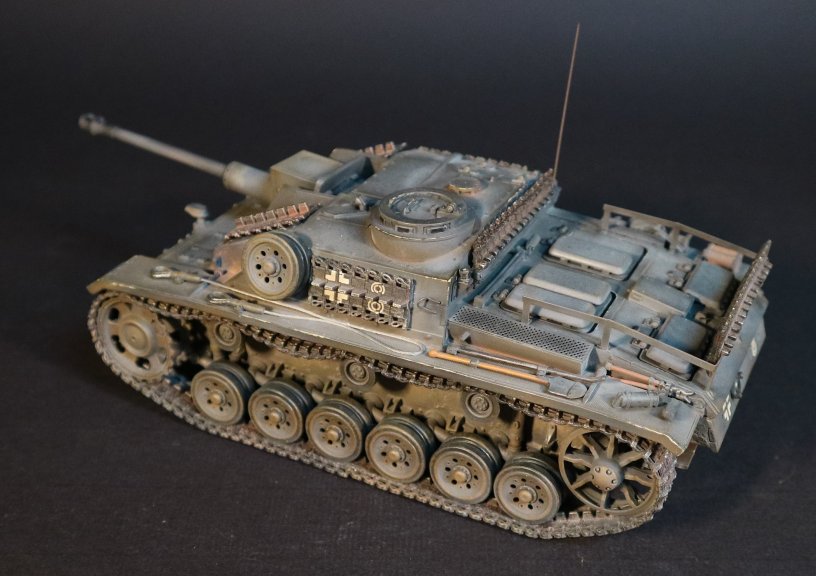
GA-22
THE SECOND WORLD WAR,
GERMAN ARMOUR,
German Sturmgeschütz III Ausf. G (Sd.Kfz. 142/1)
Initial Production
Sturmgeschütze Abteilung Grossdeutschland
Third Battle of Kharkov, February-March 1943
While the Third Battle of Kharkov will forever be associated with the SS-Panzerkorps (composed of the 1. SS-Panzergrenadier Division Liebstandarte SS Adolf Hitler, 2. SS-Panzergrenadier Division Das Reich, and 3. SS-Panzergrenadier Division Totenkopf), the critical contributions of Grossdeutschland are often overlooked. However, without Grossdeutschland, Manstein's brilliant victory would not have been possible. Furthermore, the assault guns of Sturmgeschütze Abteilung Grossdeutschland (StuG.Abt. GD), commanded by Knight's Cross holder Hauptmann Peter Frantz, played a crucial role in the division's success.
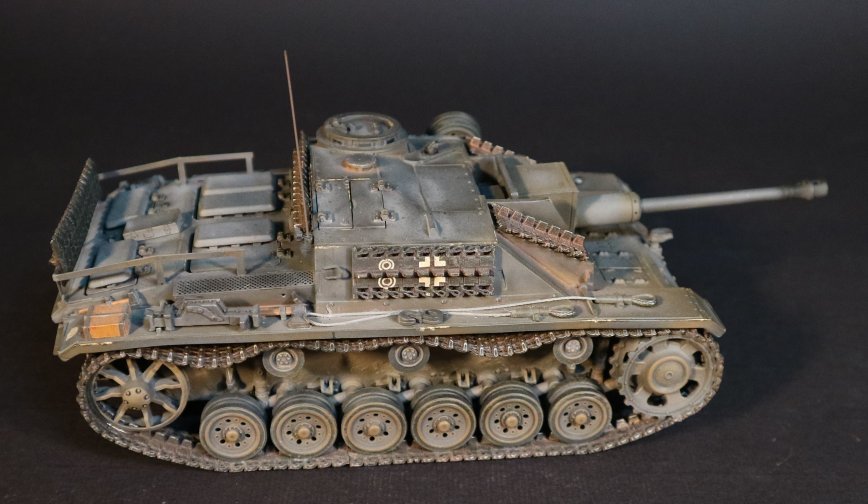
Following the encirclement of the German 6. Armee at Stalingrad, on 2 February 1943 the Russians launched Operation Star with the goal of re-taking Belgorod and Kharkov. Grossdeutschland found itself directly in the path of this onslaught by the Russian 40th Army, 69th Army, and 3rd Tank Army. While continuously pushed backwards into the northern section of Kharkov, Grossdeutschland's stalwart defense slowed the Russian's advance and allowed time for the three divisions of the SS-Panzerkorps to arrive. Despite attempts by both Grossdeutschland and the SS-Panzerkorps to hold Kharkov, the Russians were able to break through the German lines and began to encircle the city. Faced with annihilation, on 15 February both Grossdeutschland and the SS-Panzerkorps ignored Hitler's order to hold the city at all costs and abandoned Kharkov, with Grossdeutschland retreating to the west and the divisions of the SS-Panzerkorps retreating to the south and southeast.
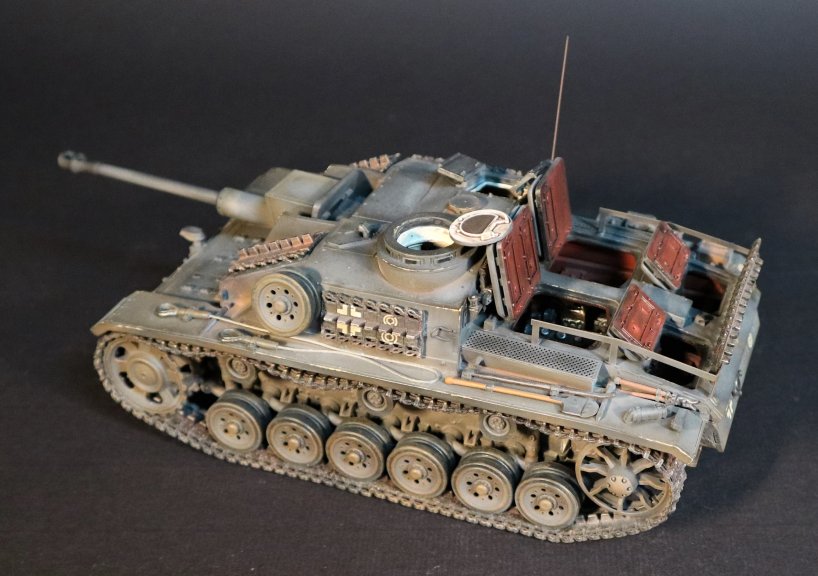
At this time, Hauptmann Fantz's StuG.Abt. GD was the most powerful armor force Grossdeutschland possessed. That same morning of 15 February, Stug.Abt. GD was reinforced with 20 new StuG IIIs, and therefore could muster a total of 30 assault guns. Thus, it was selected (along with the Pioniere Bataillon) to serve as the rear guard and cover the division's retreat. Brilliantly led by Frantz, the GD assault guns both delayed the Russians, and also saved the Fusilier Regiment GD from destruction when the regiment became surrounded by Russian armored forces. Once the retreat was completed, StuG.Abt. GD served as a defensive screen while Grossdeutschland was rapidly re-equipped in preparation for Manstein's counteroffensive.
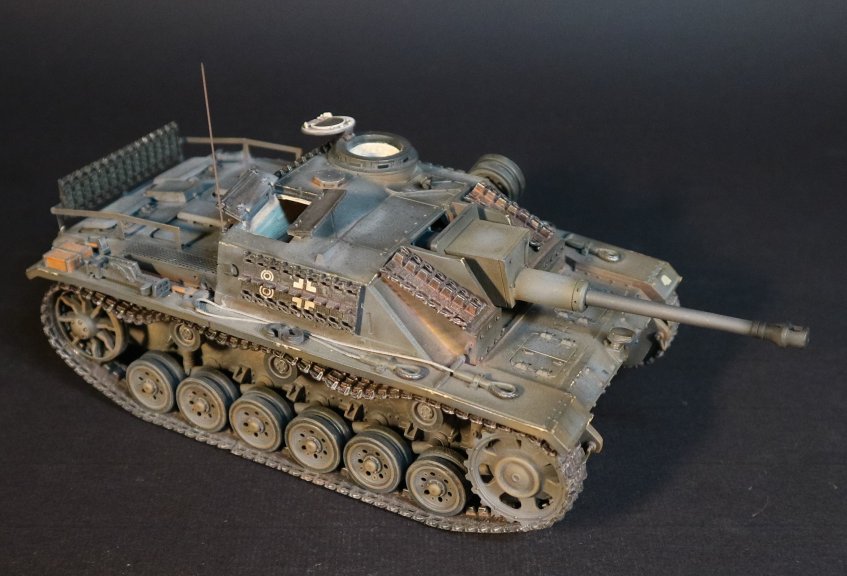
During this period, StuG.Abt. GD often served with the motorized SS-Schützen Regiment Thule, which was detached from the 3. SS-Panzergrenadier Division Totenkopf and assigned to Korps Raus (where Grossdeutschland was also assigned). Often, the soldiers of SS Regiment Thule would go into combat riding on the assault guns of Stug.Abt. GD. Together, the GD assault guns and the SS grenadiers proved a potent combat force, and solved many crises during the battle.
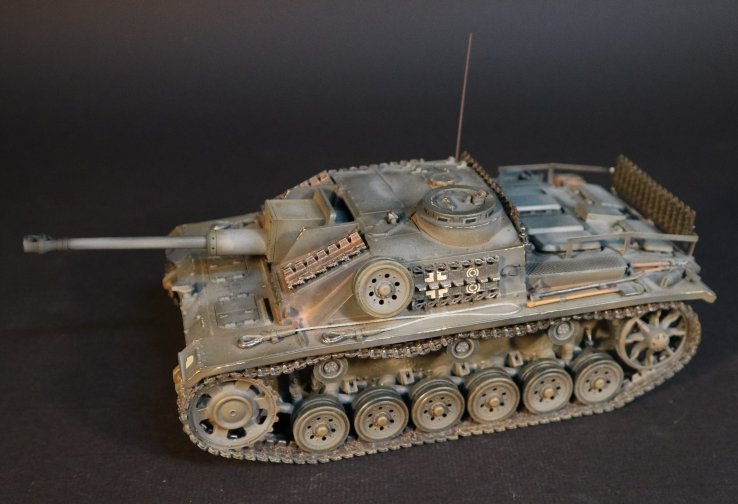
The main offensive capability available to Manstein was the SS-Panzerkorps to the south of Kharkov and Korps Raus to the west. Korps Raus was composed of a few weak infantry divisions, Grossdeutschland. Manstein envisioned using Korps Raus as the "anvil" that would hold the Russian armies in place while the SS-Panzerkorps would serve as the "hammer" and attack them in the flank and rear.
As the counteroffensive began on 7 March, Grossdeutschland lived up to its elite status. Additionally, StuG.Abt. GD performed admirably. In one particularly noteworthy engagement on 14 March, when Stug.Abt. GD, led by Hauptmann Frantz, laid a skillful ambush that mauled the Russian 2nd Guards Tank Corps and destroyed 25 tanks in a matter of minutes (Stug.Abt. GD's total for the day was 43 tanks destroyed). For this outstanding achievement, Hauptmann Franz was awarded the Oak Leaves to the Knight's Cross.
Ultimately, Manstein's counteroffensive succeded in retaking Kharkov and Belgorod and added to the battle honors of Infanterie-Division (Mot.) Grossdeutschland.
The JJ Designs initial production StuG III Ausf. G of the Sturmgeschütz Abteilung Grossdeutschland is made to JJD's high standard of technical and historical accuracy including opening hatches, a detailed fighting compartment interior, and opening engine compartments with detailed interior.
Many thanks once again to Steve (Hunter Rose) for his expertise and help.
USAAF GROUNDCREW AND PILOTS
Ground crews were responsible for keeping the aircraft of WWII in safe flying condition. Ground crew members made repairs to aircraft, as well as handling routine maintenance. As soon as a plane lands, the ground crew went to work - checking landing gear, refilling fuel tanks, examining the wings, and making any necessary repairs. Aside from regular AAF soldier schooling, ground crews were also highly trained in mathematics, mechanics, and machine shop skills. The ground crew's job was truly to "keep 'em flying."
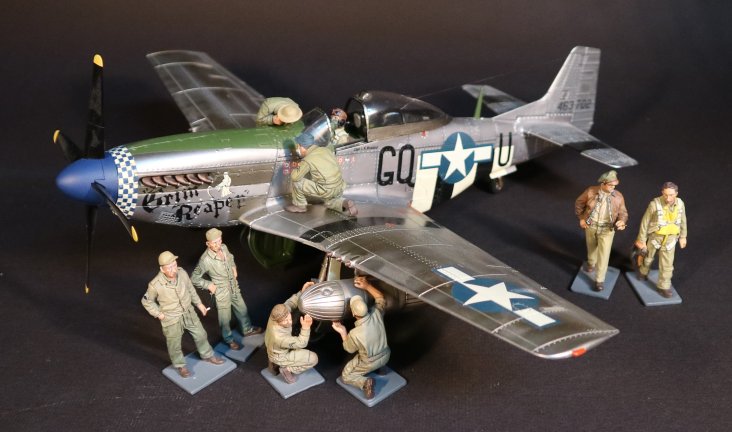
Ground Crews tirelessly maintained and repaired battle damage, and made modifications to enhance aircraft effectiveness. Their work was crucial to keeping planes operational.
The USAAF were to train hundreds of thousands of flying and ground personnel during WW2.
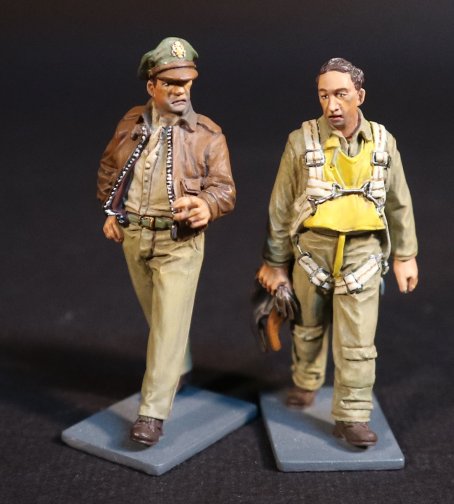
USAAF-02
THE SECOND WORLD WAR,
USAAF GROUNDCREW AND PILOTS,
OFFICER AND PILOT
The USAAF-01 model is of a P-51D named the “Grim Reaper.” It was piloted by fighter ace Capt. Lowell Brueland.
Brueland had deployed to England in November 1943 and was assigned to the 355th Fighter Squadron, 354th Fighter Group, Ninth Army Air Force.
From 1943 to 1945, Brueland was credited with the destruction of 12.5 enemy aircraft in aerial combat. He eventually became commander of the 355th Fighter Squadron in May 1945,
Capt. Brueland was awarded the Distinguished Service Cross for gallantry in action on November 8, 1944. During a fighter sweep over the St. Lo area in Normandy, France in July 1944, Brueland and his formation of eight P-51 fighters engaged over 60 German fighters and fighter bombers. In the ensuing combat, Brueland shot down three enemy fighters and damaged a fourth. Brueland and his fighter group eventually caused enemy fighters to disperse and be driven off. In addition, German fighter bombers were forced to jettison their bombs, thus eliminating a threat to the Allied front.
Brueland later served in command roles during both the Korean War and Vietnam conflict. He retired from the Air Force on December 31, 1968. He died on July 2, 2012, and was later buried at Arlington National cemetery
The P-51 Mustang fighter was manufactured in the United States during World War II (WWII). The first Mustang to come off assembly lines in California and Texas were P-51As. The P-51 was first used by the British Royal Air Force in 1942.
Starting in late 1943, the P-51B version was used by the U.S. Army Eight Air Force. Later in mid-1944, the P-51D version was introduced into the European theater. The P-51D was the most widely produced version of the Mustang during WWII and was easily recognized by its bubble top canopy and Rolls Royce Merlin engine.
The P-51D was equipped with six .50 caliber Browning machine guns holding a total compliment of 1880 rounds. The fighter also carried “zero rail” rockets under each wing and were equipped with bomb racks capable of carrying up to 1000 pounds of bombs. Because of its excellent range and maneuverability, the P-51 was primarily used as a long-range escort and as a ground attack fighter-bomber.
The Mustang was the first single engine fighter in Britain with enough fuel range to escort bombers to Germany and back. Luftwaffe Reichsmarshall Hermann Goring was quoted as saying after seeing the Mustang over Germany that “the war is lost.”
In both the European and Pacific theaters, Mustang pilots shot down a total of 4,950 enemy aircraft, and 275 P-51 pilots achieved “Ace” status.
** PLEASE CONTACT YOUR LOCAL DEALER FOR FURTHER INFORMATION **
THE SECOND WORLD WAR
GERMAN ARMOUR
German Sturmgeschütz III Ausf. G (Sd.Kfz. 142/1)
Initial Production
Sturmgeschütze Abteilung Grossdeutschland
Third Battle of Kharkov, February-March 1943
The final model of the iconic Sturmgeschütz III was the Ausfürung G, which began production in December 1942. The most noticeable upgrades to the StuG III Ausf. G was a newly designed commander's cupola that provided all-around viewports and an enlarged armored casemate that extended over the pannier sides of the hull, providing the StuG crew with a more spacious fighting compartment. Early StuG III Ausf. Gs were armed with the powerful long barrelled 7.5cm StuK 40/L48 cannon, capable of knocking out Russian T-34s and KV-1s at long range, and protected by 50mm of armor reinforced with additional 30mm armor plates bolted on top, for a total armor thickness of 80mm that provided excellent protection from the 76.2mm cannon of Russian tanks. Lastly, while in late 1942 Stug IIIs were leaving the assembly firms painted in the second Tropical camouflage scheme, photographic evidence confirms that some of the initial production StuG III Gs left the assembly firms painted in RAL 7021 Dunkelgrau...the iconic dark grey of early war German armor! Some of these grey Stug III Ausf. Gs were issued to none other than the Heer's elite unit, Infanterie-Division (Motorized) Grossdeutschland, when it participated in Generalfeldmarschall Erich von Manstein's brilliant counteroffensive during the Third Battle of Kharkov from February - March 1943.

GA-22
THE SECOND WORLD WAR,
GERMAN ARMOUR,
German Sturmgeschütz III Ausf. G (Sd.Kfz. 142/1)
Initial Production
Sturmgeschütze Abteilung Grossdeutschland
Third Battle of Kharkov, February-March 1943
While the Third Battle of Kharkov will forever be associated with the SS-Panzerkorps (composed of the 1. SS-Panzergrenadier Division Liebstandarte SS Adolf Hitler, 2. SS-Panzergrenadier Division Das Reich, and 3. SS-Panzergrenadier Division Totenkopf), the critical contributions of Grossdeutschland are often overlooked. However, without Grossdeutschland, Manstein's brilliant victory would not have been possible. Furthermore, the assault guns of Sturmgeschütze Abteilung Grossdeutschland (StuG.Abt. GD), commanded by Knight's Cross holder Hauptmann Peter Frantz, played a crucial role in the division's success.

Following the encirclement of the German 6. Armee at Stalingrad, on 2 February 1943 the Russians launched Operation Star with the goal of re-taking Belgorod and Kharkov. Grossdeutschland found itself directly in the path of this onslaught by the Russian 40th Army, 69th Army, and 3rd Tank Army. While continuously pushed backwards into the northern section of Kharkov, Grossdeutschland's stalwart defense slowed the Russian's advance and allowed time for the three divisions of the SS-Panzerkorps to arrive. Despite attempts by both Grossdeutschland and the SS-Panzerkorps to hold Kharkov, the Russians were able to break through the German lines and began to encircle the city. Faced with annihilation, on 15 February both Grossdeutschland and the SS-Panzerkorps ignored Hitler's order to hold the city at all costs and abandoned Kharkov, with Grossdeutschland retreating to the west and the divisions of the SS-Panzerkorps retreating to the south and southeast.

At this time, Hauptmann Fantz's StuG.Abt. GD was the most powerful armor force Grossdeutschland possessed. That same morning of 15 February, Stug.Abt. GD was reinforced with 20 new StuG IIIs, and therefore could muster a total of 30 assault guns. Thus, it was selected (along with the Pioniere Bataillon) to serve as the rear guard and cover the division's retreat. Brilliantly led by Frantz, the GD assault guns both delayed the Russians, and also saved the Fusilier Regiment GD from destruction when the regiment became surrounded by Russian armored forces. Once the retreat was completed, StuG.Abt. GD served as a defensive screen while Grossdeutschland was rapidly re-equipped in preparation for Manstein's counteroffensive.

During this period, StuG.Abt. GD often served with the motorized SS-Schützen Regiment Thule, which was detached from the 3. SS-Panzergrenadier Division Totenkopf and assigned to Korps Raus (where Grossdeutschland was also assigned). Often, the soldiers of SS Regiment Thule would go into combat riding on the assault guns of Stug.Abt. GD. Together, the GD assault guns and the SS grenadiers proved a potent combat force, and solved many crises during the battle.

The main offensive capability available to Manstein was the SS-Panzerkorps to the south of Kharkov and Korps Raus to the west. Korps Raus was composed of a few weak infantry divisions, Grossdeutschland. Manstein envisioned using Korps Raus as the "anvil" that would hold the Russian armies in place while the SS-Panzerkorps would serve as the "hammer" and attack them in the flank and rear.
As the counteroffensive began on 7 March, Grossdeutschland lived up to its elite status. Additionally, StuG.Abt. GD performed admirably. In one particularly noteworthy engagement on 14 March, when Stug.Abt. GD, led by Hauptmann Frantz, laid a skillful ambush that mauled the Russian 2nd Guards Tank Corps and destroyed 25 tanks in a matter of minutes (Stug.Abt. GD's total for the day was 43 tanks destroyed). For this outstanding achievement, Hauptmann Franz was awarded the Oak Leaves to the Knight's Cross.
Ultimately, Manstein's counteroffensive succeded in retaking Kharkov and Belgorod and added to the battle honors of Infanterie-Division (Mot.) Grossdeutschland.
The JJ Designs initial production StuG III Ausf. G of the Sturmgeschütz Abteilung Grossdeutschland is made to JJD's high standard of technical and historical accuracy including opening hatches, a detailed fighting compartment interior, and opening engine compartments with detailed interior.
Many thanks once again to Steve (Hunter Rose) for his expertise and help.
USAAF GROUNDCREW AND PILOTS
Ground crews were responsible for keeping the aircraft of WWII in safe flying condition. Ground crew members made repairs to aircraft, as well as handling routine maintenance. As soon as a plane lands, the ground crew went to work - checking landing gear, refilling fuel tanks, examining the wings, and making any necessary repairs. Aside from regular AAF soldier schooling, ground crews were also highly trained in mathematics, mechanics, and machine shop skills. The ground crew's job was truly to "keep 'em flying."

Ground Crews tirelessly maintained and repaired battle damage, and made modifications to enhance aircraft effectiveness. Their work was crucial to keeping planes operational.
The USAAF were to train hundreds of thousands of flying and ground personnel during WW2.

USAAF-02
THE SECOND WORLD WAR,
USAAF GROUNDCREW AND PILOTS,
OFFICER AND PILOT
The USAAF-01 model is of a P-51D named the “Grim Reaper.” It was piloted by fighter ace Capt. Lowell Brueland.
Brueland had deployed to England in November 1943 and was assigned to the 355th Fighter Squadron, 354th Fighter Group, Ninth Army Air Force.
From 1943 to 1945, Brueland was credited with the destruction of 12.5 enemy aircraft in aerial combat. He eventually became commander of the 355th Fighter Squadron in May 1945,
Capt. Brueland was awarded the Distinguished Service Cross for gallantry in action on November 8, 1944. During a fighter sweep over the St. Lo area in Normandy, France in July 1944, Brueland and his formation of eight P-51 fighters engaged over 60 German fighters and fighter bombers. In the ensuing combat, Brueland shot down three enemy fighters and damaged a fourth. Brueland and his fighter group eventually caused enemy fighters to disperse and be driven off. In addition, German fighter bombers were forced to jettison their bombs, thus eliminating a threat to the Allied front.
Brueland later served in command roles during both the Korean War and Vietnam conflict. He retired from the Air Force on December 31, 1968. He died on July 2, 2012, and was later buried at Arlington National cemetery
The P-51 Mustang fighter was manufactured in the United States during World War II (WWII). The first Mustang to come off assembly lines in California and Texas were P-51As. The P-51 was first used by the British Royal Air Force in 1942.
Starting in late 1943, the P-51B version was used by the U.S. Army Eight Air Force. Later in mid-1944, the P-51D version was introduced into the European theater. The P-51D was the most widely produced version of the Mustang during WWII and was easily recognized by its bubble top canopy and Rolls Royce Merlin engine.
The P-51D was equipped with six .50 caliber Browning machine guns holding a total compliment of 1880 rounds. The fighter also carried “zero rail” rockets under each wing and were equipped with bomb racks capable of carrying up to 1000 pounds of bombs. Because of its excellent range and maneuverability, the P-51 was primarily used as a long-range escort and as a ground attack fighter-bomber.
The Mustang was the first single engine fighter in Britain with enough fuel range to escort bombers to Germany and back. Luftwaffe Reichsmarshall Hermann Goring was quoted as saying after seeing the Mustang over Germany that “the war is lost.”
In both the European and Pacific theaters, Mustang pilots shot down a total of 4,950 enemy aircraft, and 275 P-51 pilots achieved “Ace” status.
** PLEASE CONTACT YOUR LOCAL DEALER FOR FURTHER INFORMATION **

